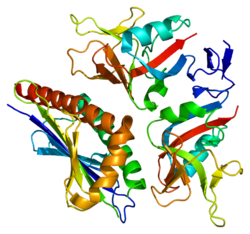| ULBP3 | |||||||||||||||||||||||||||||||||||||||||||||||||||
|---|---|---|---|---|---|---|---|---|---|---|---|---|---|---|---|---|---|---|---|---|---|---|---|---|---|---|---|---|---|---|---|---|---|---|---|---|---|---|---|---|---|---|---|---|---|---|---|---|---|---|---|
 | |||||||||||||||||||||||||||||||||||||||||||||||||||
| |||||||||||||||||||||||||||||||||||||||||||||||||||
| Identifiers | |||||||||||||||||||||||||||||||||||||||||||||||||||
| Aliases | ULBP3, RAET1N, N2DL-3, NKG2DL3, UL16 binding protein 3 | ||||||||||||||||||||||||||||||||||||||||||||||||||
| External IDs | OMIM: 605699; HomoloGene: 129737; GeneCards: ULBP3; OMA:ULBP3 - orthologs | ||||||||||||||||||||||||||||||||||||||||||||||||||
| |||||||||||||||||||||||||||||||||||||||||||||||||||
| |||||||||||||||||||||||||||||||||||||||||||||||||||
| |||||||||||||||||||||||||||||||||||||||||||||||||||
| |||||||||||||||||||||||||||||||||||||||||||||||||||
| Wikidata | |||||||||||||||||||||||||||||||||||||||||||||||||||
| |||||||||||||||||||||||||||||||||||||||||||||||||||
UL16 binding protein 3 (ULBP3) is a cell surface glycoprotein encoded by ULBP3 gene located on the chromosome 6. ULBP3 is related to MHC class I molecules, but its gene maps outside the MHC locus. The domain structure of ULBP3 differs significantly from those of conventional MHC class I molecules. It does not contain the α3 domain and the transmembrane segment. ULBP3 is thus composed of only the α1α2 domain which is linked to the cell membrane by the GPI anchor. It functions as a stress-induced ligand for NKG2D receptor.
References
- ^ GRCh38: Ensembl release 89: ENSG00000131019 – Ensembl, May 2017
- "Human PubMed Reference:". National Center for Biotechnology Information, U.S. National Library of Medicine.
- ^ Cosman D, Müllberg J, Sutherland CL, Chin W, Armitage R, Fanslow W, Kubin M, Chalupny NJ (Feb 2001). "ULBPs, novel MHC class I-related molecules, bind to CMV glycoprotein UL16 and stimulate NK cytotoxicity through the NKG2D receptor". Immunity. 14 (2): 123–33. doi:10.1016/S1074-7613(01)00095-4. PMID 11239445.
- ^ Radosavljevic M, Cuillerier B, Wilson MJ, Clément O, Wicker S, Gilfillan S, Beck S, Trowsdale J, Bahram S (Jan 2002). "A cluster of ten novel MHC class I related genes on human chromosome 6q24.2-q25.3". Genomics. 79 (1): 114–23. doi:10.1006/geno.2001.6673. PMID 11827464.
Further reading
- Cerwenka A, Lanier LL (May 2003). "NKG2D ligands: unconventional MHC class I-like molecules exploited by viruses and cancer". Tissue Antigens. 61 (5): 335–43. doi:10.1034/j.1399-0039.2003.00070.x. PMID 12753652.
- Eleme K, Taner SB, Onfelt B, Collinson LM, McCann FE, Chalupny NJ, Cosman D, Hopkins C, Magee AI, Davis DM (Apr 2004). "Cell surface organization of stress-inducible proteins ULBP and MICA that stimulate human NK cells and T cells via NKG2D". The Journal of Experimental Medicine. 199 (7): 1005–10. doi:10.1084/jem.20032194. PMC 2211882. PMID 15051759.
- Sutherland CL, Chalupny NJ, Schooley K, VandenBos T, Kubin M, Cosman D (Jan 2002). "UL16-binding proteins, novel MHC class I-related proteins, bind to NKG2D and activate multiple signaling pathways in primary NK cells". Journal of Immunology. 168 (2): 671–9. doi:10.4049/jimmunol.168.2.671. PMID 11777960.
- Radaev S, Rostro B, Brooks AG, Colonna M, Sun PD (Dec 2001). "Conformational plasticity revealed by the cocrystal structure of NKG2D and its class I MHC-like ligand ULBP3". Immunity. 15 (6): 1039–49. doi:10.1016/S1074-7613(01)00241-2. PMID 11754823.
- Steinle A, Li P, Morris DL, Groh V, Lanier LL, Strong RK, Spies T (2001). "Interactions of human NKG2D with its ligands MICA, MICB, and homologs of the mouse RAE-1 protein family". Immunogenetics. 53 (4): 279–87. doi:10.1007/s002510100325. PMID 11491531. S2CID 33695596.
| PDB gallery | |
|---|---|
This article on a gene on human chromosome 6 is a stub. You can help Misplaced Pages by expanding it. |


